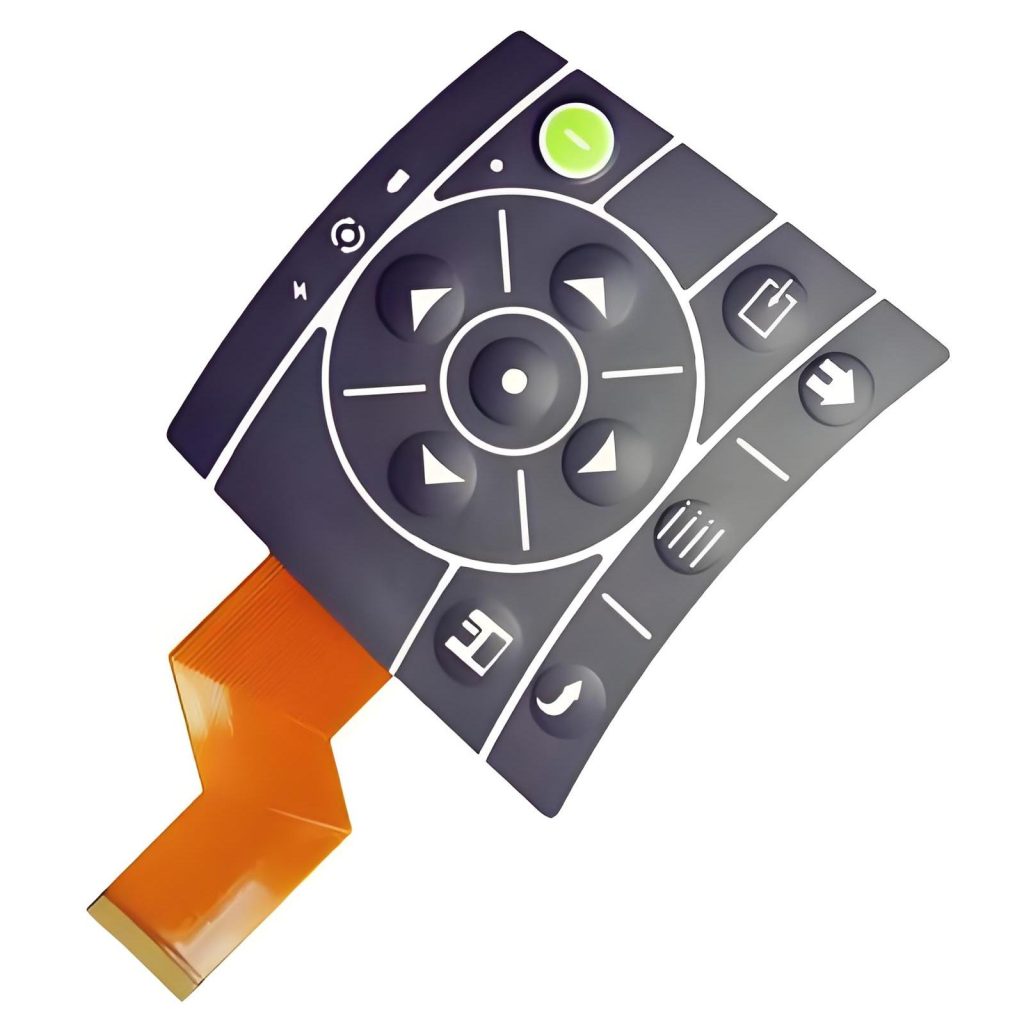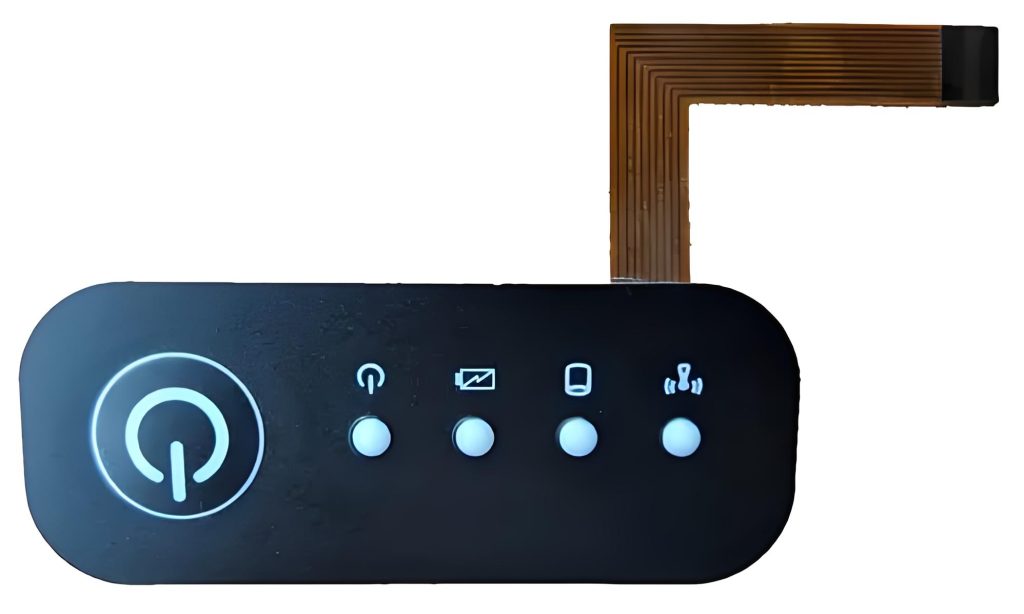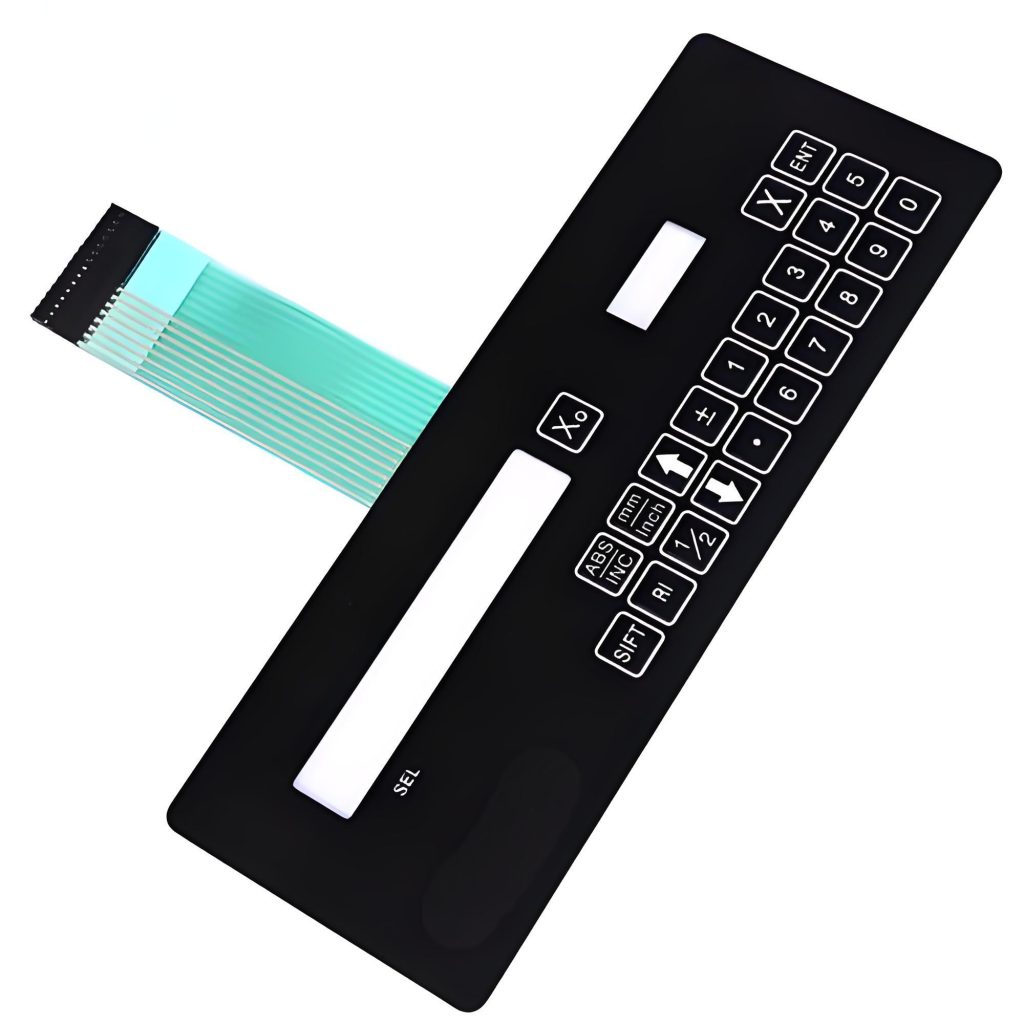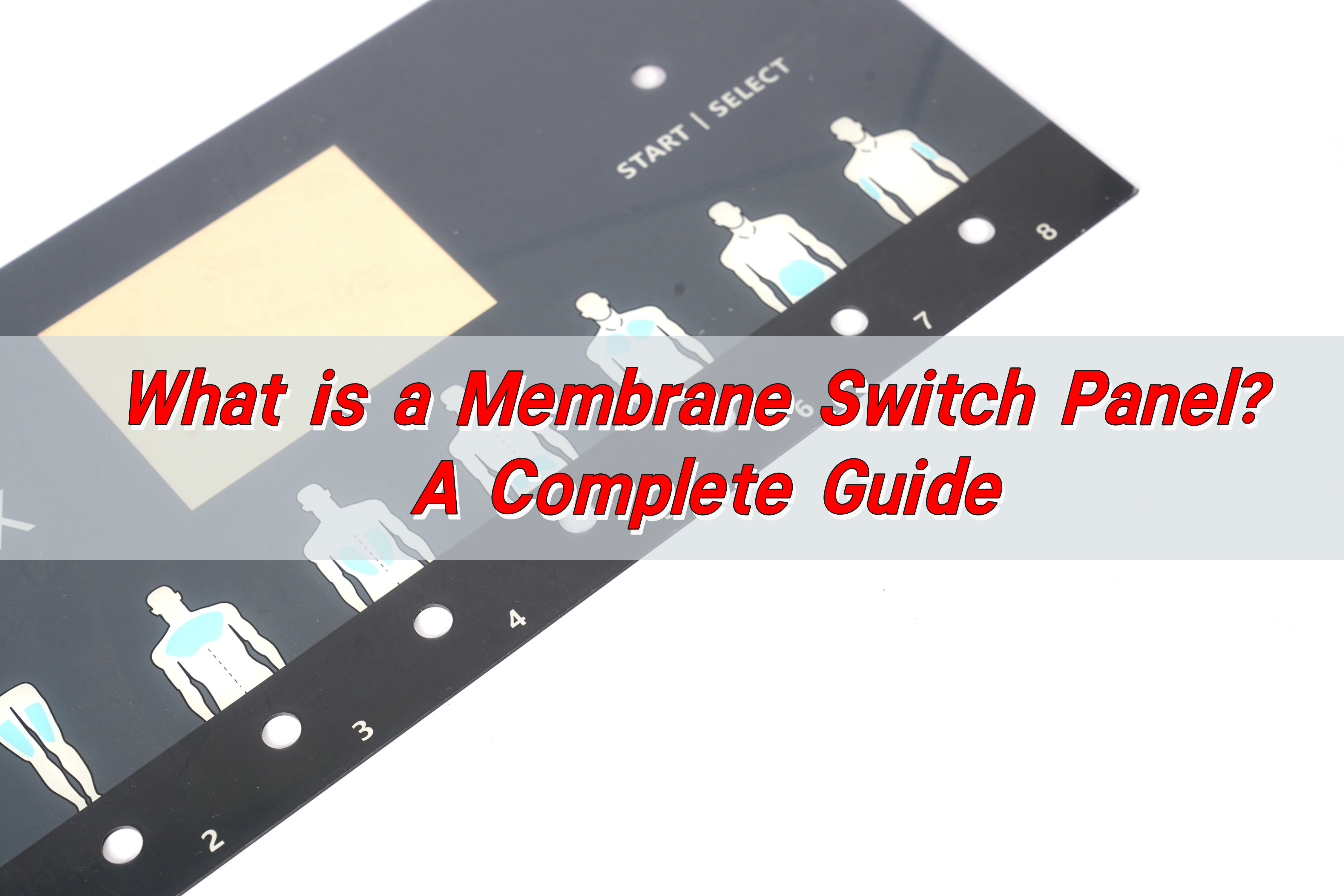
How does a membrane switch work?
How does a membrane switch work?
The membrane switch transmits pressure to the circuit layer by the user pressing the panel layer, so that the conductive material contacts to form a circuit to generate an electrical signal, which is transmitted to the control system to perform the operation. After releasing, it returns to its original state and waits for the next operation. It is mainly composed of a panel layer, an isolation layer, a circuit layer and a backing layer. Each layer works together to realize the unique function of the membrane switch.
What is a membrane key switch?
A membrane key switch is a switch element commonly used in the control panel of electronic equipment. It converts key operations into electrical signals. Its structure is a combination of multiple layers of film. It plays a key role in many electronic devices and is an important component for realizing human-computer interaction.

It is mainly composed of a panel layer, an isolation layer, a circuit layer and a backing layer. The panel layer is generally a polyester film, which is wear-resistant and printed with logos. The isolation layer acts as an insulator to prevent short circuits. The circuit layer has conductive ink or metal materials to form a circuit. The backing layer is used to stick on the device.
When the key is pressed, the panel layer is subjected to force and transmitted to the circuit layer. If there is a structure with metal shrapnel, the shrapnel deforms and contacts the circuit, or the conductive ink closely contacts the corresponding conductive part, so that the circuit is turned on to generate an electrical signal, and the circuit is restored to the disconnected state after release.
The membrane key switch is light and portable, which saves more space than traditional mechanical keys and is conducive to the thin and light design of electronic equipment. Exquisite patterns can be printed on the appearance to improve the appearance of the equipment.
It has good sealing performance and can effectively block dust, moisture and oil, suitable for a variety of environments. And the cost is relatively low in large-scale production, the production process is simple, and the production efficiency is high.
How do membrane switches work?
The top layer of the membrane switch is the panel layer. When the key area on the panel layer is pressed, the pressure is transmitted downward. If there is a metal shrapnel, it will cause elastic deformation, so that the shrapnel contacts the lower circuit layer or the distance between the conductive materials of the circuit layer is reduced to a conductive level.
After the mechanical action makes the metal shrapnel or conductive material contact each other, the circuit layer (circuit pattern composed of conductive ink or metal foil, etc.) is turned on, the current flows in the circuit, and the electrical signal is transmitted from the power supply end along the circuit to the control circuit inside the device, and the control circuit performs the corresponding operation accordingly.
After the finger releases the button, the metal shrapnel returns to its original state due to elasticity or the contact between the conductive materials is released, the circuit is disconnected, and the next button operation is waited for to trigger the conduction again, completing a human-computer interaction.
What is the function of a membrane switch?
1. Realize human-computer interaction
The membrane switch is an important human-computer interaction interface. When the user presses the button on the membrane switch, the operation intention can be converted into an electrical signal and transmitted to the device control unit, so that the device responds accordingly, which is convenient for the user to control the device and realize information transmission and interaction.
2. Beautify the appearance and clear identification

The panel layer of the membrane switch can achieve a variety of appearance effects, which can match the design of the device shell and enhance the overall aesthetics of the product. At the same time, the panel layer can clearly print the button logo, such as text, icons or a combination of the two, so that users can quickly and accurately identify the operation, improve convenience and safety.
3. Protect circuits and enhance durability
The multi-layer structure of membrane switches can prevent dust, moisture, oil, etc. from damaging the internal circuits, such as equipment in outdoor or industrial environments, which can extend the life of the equipment. Moreover, the membrane switch material is wear-resistant, corrosion-resistant, and flexible. It can maintain good performance in frequent operation occasions and ensure long-term stable operation of the equipment.
What are the parts of a membrane switch?
- Panel layer: The panel layer of the membrane switch is mostly polyester film (PET), which has good flexibility, wear resistance, and strong chemical stability. As the part that the user directly contacts, it is printed with patterns, texts, and icons to indicate the function of the buttons.
- Isolation layer: The isolation layer is generally polyester film, which can prevent the conductive part of the circuit layer from short-circuiting, ensure the independence of each button circuit, and enhance the structural stability of the membrane switch.
- Circuit layer: The circuit layer is the core, and the conductive materials include conductive ink (low cost, can achieve complex design) and metal foil (high conductivity and stability). When the button is pressed, the circuit layer forms a path to generate an electrical signal, which is transmitted to the device control unit.
- Adhesive layer: The adhesive layer is at the bottom. Use pressure-sensitive adhesive to stick the membrane switch on the device panel. Consider compatibility with the device surface material, temperature resistance and chemical resistance.
What material is a membrane switch made of?
1. Panel layer
- Polyester film (PET): Good flexibility, can fit a variety of device surfaces; wear-resistant, long-term use of patterns and text is not easy to blur; strong chemical stability, can resist corrosion from a variety of chemicals. Commonly used in the panel layer of membrane switches.
- Polycarbonate (PC): High transparency, suitable for membrane switches with backlight function, can better show the backlight effect; good strength and toughness, can withstand certain external impact, but chemical resistance is slightly inferior to PET.
2. Isolation layer
- Polyester film (PET): Good insulation performance, can prevent short circuit of the conductive part of the circuit layer, and ensure the independence of each key circuit; moderate thickness and flexibility, can play a good isolation and buffering role between the panel layer and the circuit layer.
3. Circuit layer
- Conductive ink: Contains conductive particles, can form complex circuit patterns through screen printing, low cost, suitable for large-scale production and multiple functional layouts, but slightly poor conductivity and stability.
- Metal foil (such as copper foil, aluminum foil): High conductivity and stability, copper foil is often used in membrane switches with high signal quality requirements; aluminum foil has low cost and is used in situations where conductivity requirements are not particularly high, but the metal foil processing technology is more complicated.
4. Adhesive layer
- Pressure sensitive adhesive (PSA): Good viscosity, can firmly adhere to the membrane switch after pressure, and easy to peel off; must be compatible with different equipment surface materials, and must have certain temperature resistance and chemical resistance.
What are the applications of membrane switch?
The application field of membrane switches is very wide, mainly including the following aspects:
- 1. Medical equipment: Membrane switches are widely used in medical equipment, such as sphygmomanometers, thermometers, electrocardiographs, etc.
- 2. Instruments: Membrane switches are widely used in the control panels of instruments to provide interactivity and functionality.
- 3. Industrial control: In the field of industrial control, membrane switches are usually used as automatic control equipment or equipment controllers to monitor the production process.

- 4. Household appliances: Membrane switches are widely used in the field of household appliance control, such as televisions, air conditioners, washing machines, etc.
- 5. Automotive electronics: Membrane switches are also widely used in the field of automotive electronics, such as in-car air conditioning, audio, navigation, etc., and can also improve the beauty and comfort of the interior of the car.
- 6. Communication products: Membrane switches are widely used in communication products, such as mobile phones, PHS, cordless phones, walkie-talkies, etc.
- 7. Electronic toys: Membrane switches are also used in smart toys to provide operating interfaces and functions.
- 8. Electromechanical products: In electromechanical products such as CNC machine tools, robots, and printing machinery, membrane switches provide operating and control functions.
- 9. Computers: In the computer field, membrane switches are used to operate keyboards, monitors, printers, plotters and other equipment.
What is the difference between mechanical and membrane switches?
There are significant differences between mechanical switches and membrane switches in terms of working principles, structural characteristics and application scenarios.
1. Working principle
- Mechanical switch: The mechanical parts (such as contacts, springs, etc.) inside the switch are moved by physical force (such as pressing, rotating, etc.) to connect or disconnect the circuit. This type of switch usually requires a large operating force and is suitable for environments with frequent operations.
- Membrane switch: The middle layer of transparent film is in contact with the conductive material, and the switch operation is realized by touch or light pressure sensing. When external force acts on the membrane switch, the circuit board under the membrane contacts the metal point, thereby generating a switch action.
2. Structural characteristics
- Mechanical switch: The structure is relatively complex and usually consists of metal parts. Because of its solid structure, it can withstand large mechanical loads and vibrations, and is suitable for occasions requiring high reliability and stability.
- Membrane switch: The structure is simple and has the characteristics of being thin, light and flexible. The sensing element of the membrane switch is a transparent film. Because of its simple structure and flexible installation, it is suitable for small electronic products.
3. Application scenarios
- Mechanical switch: Commonly used in automobiles, machine tools, household appliances and other fields. Because of its large operating force, it is suitable for occasions where manual frequent switching or power supply disconnection is required.
- Membrane switch: widely used in home appliances, electronic instruments, mechanical equipment and other fields. Because of its beautiful appearance, simple structure and flexible installation, it is particularly suitable for small electronic products such as mobile phones, MP3, tablet computers, etc.
4. Comparison of advantages and disadvantages
Mechanical switch:
- Advantages: strong structure, can withstand large mechanical loads and vibrations, and has a long service life.
- Disadvantages: large operating force, not suitable for fine operation, large size.
Membrane switch:
- Advantages: small operating force, suitable for fine operation, small size, light weight, and flexible installation.
- Disadvantages: relatively short service life, generally more than 10,000 times, not as durable as mechanical switches.
In summary, mechanical switches and membrane switches have their own advantages and disadvantages, suitable for different application scenarios and needs.
In short, membrane switches have become an indispensable key component in modern electronic devices with their unique structure and working principle. Its advantages such as lightness, portability, beautiful appearance, good sealing, convenient operation and low cost have made it widely used in consumer electronics, medical equipment, industrial control and automotive electronics.

What is a Membrane Switch Panel? A Complete Guide
Membrane switch panel is a thin, beautiful electronic component that integrates key functions, indicator components and instrument panels. It consists of a panel, an upper circuit, an isolation layer and a lower circuit. When pressed, the upper circuit contacts and the lower circuit are connected. When released, the contact rebounds and the circuit is disconnected. ...
Custom Silicone Rubber Membrane Switch & Rubber Keypad
Silicone rubber membrane switch is a membrane switch made of silicone rubber material, which has the advantages of silent operation, high temperature resistance and stable chemical properties. It changes the structure of the traditional touch switch using metal shrapnel and uses silicone rubber as the conductive material, so it is also called a silent touch ...

Why choose a PET membrane switch? Key benefits you should know
PET membrane switches have good key life, corrosion resistance, wear resistance, and excellent insulation performance, and are suitable for key parts that are used frequently. They have high hardness and can withstand large key forces, ensuring long-term stability. In addition, PET membrane switches have good temperature resistance and can operate in a temperature range of ...
Contact us online